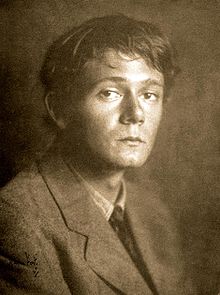Clark Ashton Smith | |
|---|---|
 Smith in 1912 | |
| Born | January 13, 1893 Long Valley, California, U.S. |
| Died | August 14, 1961 (aged 68) Pacific Grove, California, U.S. |
| Occupation | Short story writer, poet |
| Genre | Horror, fantasy, science fiction, dark fantasy |
| Spouse |
Carol Jones Dorman (m. 1954) |
Clark Ashton Smith (January 13, 1893 – August 14, 1961) was an influential American writer of fantasy, horror, and science fiction stories and poetry, and an artist. He achieved early recognition in California (largely through the enthusiasm of George Sterling) for traditional verse in the vein of Swinburne. As a poet, Smith is grouped with the West Coast Romantics alongside Joaquin Miller, Sterling, and Nora May French and remembered as "The Last of the Great Romantics" and "The Bard of Auburn". Smith's work was praised by his contemporaries. H. P. Lovecraft stated that "in sheer daemonic strangeness and fertility of conception, Clark Ashton Smith is perhaps unexcelled", and Ray Bradbury said that Smith "filled my mind with incredible worlds, impossibly beautiful cities, and still more fantastic creatures".[1] Additional writers influenced by Smith include Leigh Brackett, Harlan Ellison, Stephen King, Fritz Lieber, George R. R. Martin, and Donald Sidney-Fryer.
Smith was one of "the big three of Weird Tales, with Robert E. Howard and H. P. Lovecraft",[2] though some readers objected to his morbidness and violation of pulp traditions. The fantasy writer and critic L. Sprague de Camp said of him that "nobody since Poe has so loved a well-rotted corpse".[3] Smith was a member of the Lovecraft circle, and his literary friendship with Lovecraft lasted from 1922 until Lovecraft's death in 1937. His work is marked by an extraordinarily rich and ornate vocabulary, a cosmic perspective and a vein of sardonic and sometimes ribald humor.
Of his writing style, Smith stated: "My own conscious ideal has been to delude the reader into accepting an impossibility, or series of impossibilities, by means of a sort of verbal black magic, in the achievement of which I make use of prose-rhythm, metaphor, simile, tone-color, counter-point, and other stylistic resources, like a sort of incantation."[4]
- ^ Michael Dirda, "A Journey to the Fantastic Realms of Clark Ashton Smith" Archived April 21, 2019, at the Wayback Machine. The Washington Post, February 18, 2007. Retrieved January 28, 2019.
- ^ Thomas, G. W. "A Reader's Guide to Sword & Sorcery S-V". Archived from the original on May 28, 2010. Retrieved September 27, 2012.
- ^ de Camp 1976, p. 206
- ^ "Introduction to 'Tales of Zothique' by Will Murray". eldritchdark.com. Archived from the original on March 3, 2016. Retrieved March 15, 2016.